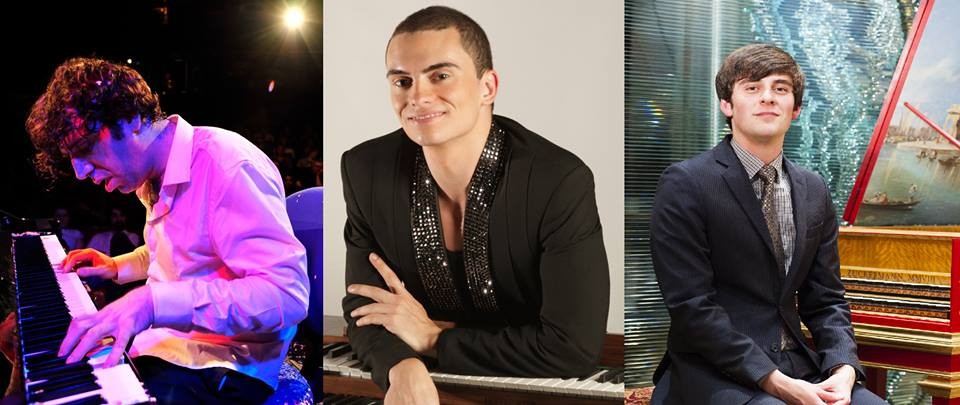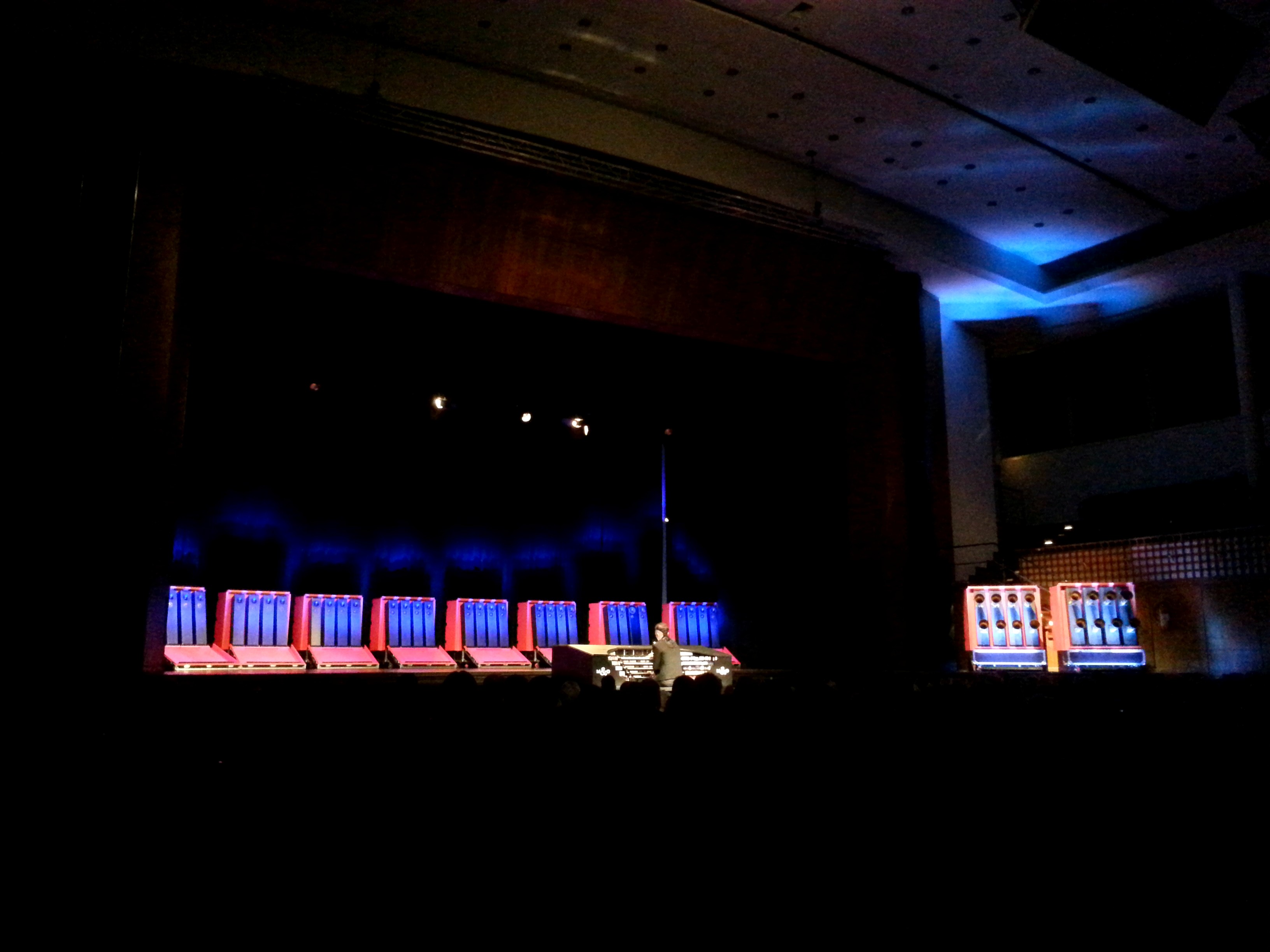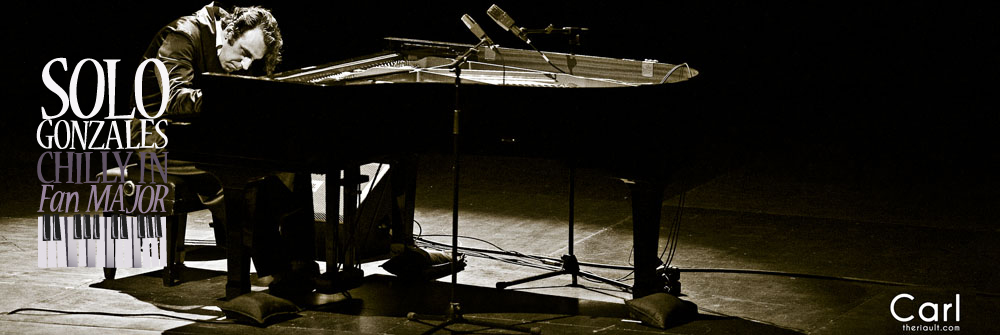 When I witnessed Cameron Carpenter mastering his International Touring Organ and making this incredible machine come alive in Zurich last Sunday night, I instantly had Chilly Gonzales’ words in mind, when he called The BBC Symphony Orchestra he played with in London 2012 “the world’s most expensive synthesizer”. It was apparently another fulfilled longing to have one of those “synthesizers” all to himself. Carpenter’s digital organ might be even more expensive, the inner urge to create such an instrument, find sponsors and then actually use it, is the same. The obvious connection between the two musicians – apart from their dedication to key instruments – as Chilly Gonzales would put it: They are men of their (and our) time. They have a vision – the vision to take music to the next level. To keep the roots, but cut the weed. To not see music as something written in stone, but something versatile, adaptable and re-inventable as well as re-interpretative.So in an ideal world, these two should work together and as we sometimes like to daydream at SoloGonzales, we already have an idea how: with harpsichordist Christopher Lewis on board in a concert dedicated to “The Evolution of the Keys”.
When I witnessed Cameron Carpenter mastering his International Touring Organ and making this incredible machine come alive in Zurich last Sunday night, I instantly had Chilly Gonzales’ words in mind, when he called The BBC Symphony Orchestra he played with in London 2012 “the world’s most expensive synthesizer”. It was apparently another fulfilled longing to have one of those “synthesizers” all to himself. Carpenter’s digital organ might be even more expensive, the inner urge to create such an instrument, find sponsors and then actually use it, is the same. The obvious connection between the two musicians – apart from their dedication to key instruments – as Chilly Gonzales would put it: They are men of their (and our) time. They have a vision – the vision to take music to the next level. To keep the roots, but cut the weed. To not see music as something written in stone, but something versatile, adaptable and re-inventable as well as re-interpretative.So in an ideal world, these two should work together and as we sometimes like to daydream at SoloGonzales, we already have an idea how: with harpsichordist Christopher Lewis on board in a concert dedicated to “The Evolution of the Keys”.
Entering the Kongresshaus, one could feel a certain degree of tension in the room that is unusual for concerts of that kind. People were starring at the stage, on which eight big boxes containing amplifiers aflamed in red and blue light were the protagonists. In front, the extraterrestrial console in black and white, a spaceship for Carpenters sound sorcery. Some of the audience members even gathered around the instrument (also during the pause and at the end), with their mouths wide open and a certain disbelief in their eyes, as if they had just seen the first locomotive or light bulp. Others were taking photographs.  A scent of entrepreneur-
A scent of entrepreneur-
ship and extravaganza wafted through the air, while everyone eagerly waited for the first tone to arise. From gentle to dramatic, silent to full blast, softly whispering to imbuing, full orchestra sound to cinematic samples – the Machina Magna did not disappoint and so did Cameron Carpenter. It took ten years from first sketch to finally finishing the instrument. It fits in one truck, is ready to play within three hours and back in the boxes in one hour. A 21st century counterdraft of Frankenstein’s Monster with a happy ending. When you see Carpenter hitting the keys, constantly pushing buttons, dancing on the foot pedals – as if he had the extremities of an octopus – and with an expression lost in music, facing the sound, it is as if this digital organ finally enables him to express how he has always perceived the pieces – no matter if classical, modern or self-composed. As if he had always heard things when reading scores others hadn’t and is now able to make them audible for everyone.
« Against all odds »-attitude and pioneer spirit
What unifies Carpenter and Gonzales is the approach to de-dust music – no matter if Carpenter interpretes Bach in his own way or if Gonzales composes a baroque yet modern piece like Escher. In both cases even the old maestro would be thrilled to see that his music actually has grown over the centuries and still inspires to create something different. It is also the idea to revive « pop » in the broadest sense and presumed dead (like the organ) and bring them to the concert halls. Gonzales does it his way, for example by making a classical orchestra play his rap pieces and Britney Spears /Michael Jackson mash ups, Carpenter by creating an organ that combines the best features of a traditional church organ with the techniques of today and making the instrument location-independent. Before, he had to get a feeling for the instrument that was on site – often not well-maintained church organs – now he needs to get adjusted to different locations, yet the instrument stays the same. That way the organ is on its way to revolutionize concert halls [now imagine Chilly Gonzales stage dive Barbican Hall to the sounds of Cameron Carpenter's organ]. Both are also great composers. The whole range of the feasible becomes alive, when Carpenter plays his own dramatic piece “Music for an Imaginary Film” that he created especially for the touring organ. And Gonzales actually almost only plays and sells his own compositions. Remarkably enough, his commercially most successful albums are the albums Solo Piano and Solo Piano II that are pure piano pleasure, i.e. the essence of contemporary “pop” composing on a classical basis and with a distinct feeling for melody and harmony as part of the musical maths.
The “against all odds”-attitude and pioneer spirit is another aspects both artists have in common. In Gonzales’ case there are several examples, from battling himself by playing the piano for 27 hours straight and breaking a Guinness World Record to getting a Grammy for his contributions to Daft Punk’s latest album, becoming “Rapper’s Delight” by turning himself into a thought-after collaborator for some well-known rap-homies or emancipating himself from record labels in order to remain independent AND successful. Carpenter is known for his furious, very dynamic play and special interpretations of classics that he transcribes himself for the organ – each aspect by itself an affront of the small and not very innovative organ “scene”. At the same time and by being that way, both manage to attract a younger audience and transport unspoken messages like “playing the piano is cool” and “the organ is probably the greatest playground we have in music”. Also remarkable is Carpenter’s sheer will and belief to hold on to a vision and live a dream that might have seemed impossible 15 years ago, but is now reality – the International Touring Organ.
Perfection and periwig
If you see both artists in action, you surely become aware of the high level of craftsmanship and life-long study behind their play. Both don’t just know how to make a show and entertain, but also how to “inhale” a piece and perform it to perfection on the basis of a profound musical education.
Perfection is another link between the two. In Carpenter’s case, he seems to have anything under control starting with his appearance and ending with his instrument. In Gonzales’ case every performance is the result of real brain work. It may seem improvised, but be assured it isn’t in most cases – or it is improvised within a frame of maximum control. Also, from album art work to the selection of the titles and writing PR statements, Gonzales’ surely delegates, but always is the one who holds the reins. His stage outfit of dressing gown and slippers may seem almost random to some first time-audience members or even a bit sloppy, yet his robe is tailor-made by one of Germany’s finest designers Herr von Eden and the whole look aims to create a feel of intimacy and turn a piano concert into a less formal and stiff occasion. It’s a play with expectations, much like Carpenter does it. You wouldn’t expect an organ player wearing dancing shoes that he designed himself and decorated with Svarowsky crystals or displaying his trained body. Also when it comes to Carpenter – nothing is coincidence. From behind and a little distance, even his version of a black Mohawk hairdo looks like a modern or maybe ironic interpretation of former centuries’ powder-white periwigs.
A periwig would be the perfect accessory for Christopher Lewis, the third key-musketeer in the league. Still, he’s far away from wearing one, because he is the pioneer of the modern, or as he would say “contemporary” harpsichord. Not only that he picks up pieces by composers like Philip Glass or John Rutter and records them for Naxos records (http://www.christopherlewis.net/discography.html ), but he also demonstrates and impersonates that an instrument like the harpsichord is still an important component of today’s music. He is also keeper of the largest collection of « Pop Harpsichord Music » on the WWW: http://www.christopherlewis.net/pop-music.html .
So, back to the beginning of this post and let’s repeat SoloGonzales’ vision: a concert or collaboration of these three extraordinary musicians. Actually, I’m glad to be a woman of my time – because these are the Wunderkinder, or rather Wundermen, of our time and as their contemporaries, we shall be very aware of it.
